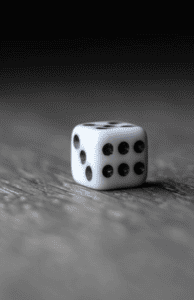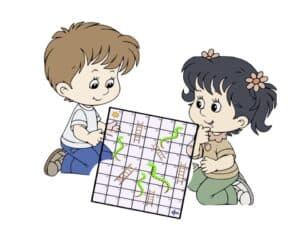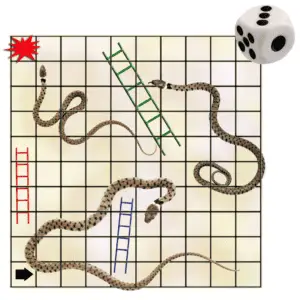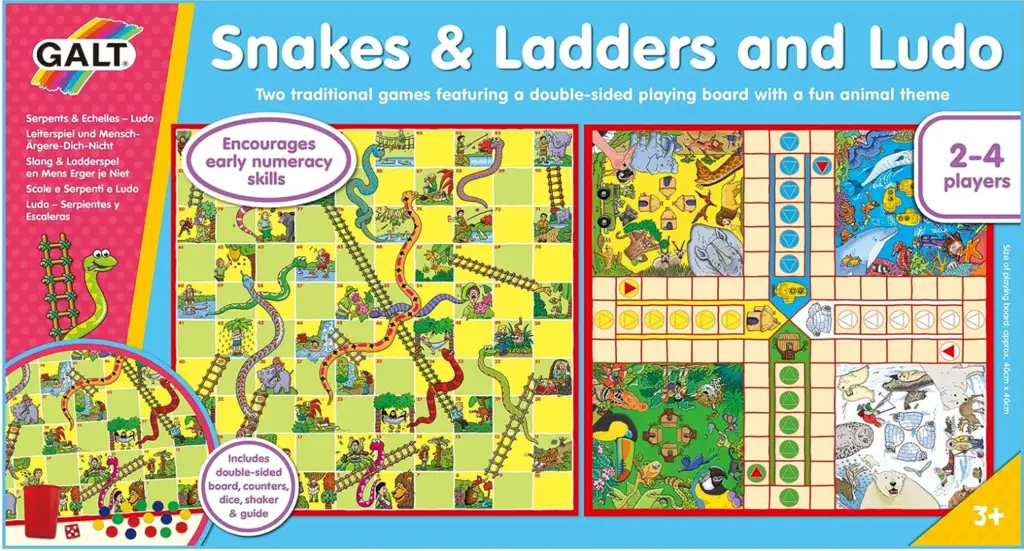Snakes and Ladders is one of the most recognizable board games today. Originated in ancient India around the 13th century AD, the game was designed to teach children the cause and effect of good and bad deeds. Today’s version of the game teaches important life skills while having fun.

On average, 4 is a good age to introduce Snakes and Ladders as players only need to know numbers 1-6 to play. To teach the game to young players with short attention spans, limit the number of players to 2. This allows little downtime between turns, making the game more enjoyable for both.
The objective of Snakes and Ladders
Snakes and Ladders is a race to the finish. To begin, all players place their chosen game piece on the ONE square. Each player rolls the die. The player with the highest number of pips (dots) goes first.
That player rolls again and moves their character one square for each pip on the die. Each player gets one turn at a time unless a six is rolled, which in that case, the player may roll again. After the player has moved their game piece, their turn is over, and play continues on to the player to the left.
Landing on a snake or ladder: if a player’s turn ends on the bottom of the ladder, move that game piece up the ladder, advancing the player forward. If a player’s turn ends at the top of a snake, move the game piece down the snake body to the tail, moving that player back to an already traveled area. It’s possible and often happens, that players climb ladders or fall down snakes more than one time in a game.
The winner is the player who play reaches the last top square. The number varies from 36-100 depending on the size of the board.
At What Age Can I Teach My Child to Play?
On average, 4 is a good age to teach Snakes and Ladders, as they have begun to develop their listening and communication skills.
Most children around the age of 4 begin to interact with others during play. Playing games encourages this growth of socialization, taking turns, and cooperation.
Snakes and Ladders only require one to know numbers 1-6 to play. Most 4-year-olds know how to count this high, but even if they don’t, teaching to recognize the die and count will only take minutes, not hours or days as with a younger child.
How Can I Teach My Child to Play Snakes and Ladders?
On average, 4 is a good age to teach Snakes and Ladders, as they have begun to develop their listening and communication skills.

Before playing the game, point out where you begin and end the game. Show them the route using your finger, while stopping at the snakes and ladders to explain what happens if their token lands on either.
Review the game instructions aloud. It’s helpful to ask them to repeat back what they heard so you can be sure they understand how to play.
If your child has not played with dice before, let them roll a time or two before beginning. Encourage them to keep from throwing the die too hard or throwing the die across the table, but to give the die a gentle roll to land in front of the player and not on the board.
What life lessons can be taught by Snakes & Ladders?

Novelist Diane Ackerman says: “Play is our brain’s favorite way of learning”. Playing games benefit children’s brains and personal development. Some of the most obvious benefits in Snakes & Ladders are counting spaces, patience while waiting their turn, and the dexterity in moving pieces around the board. But playing board games like Snakes & Ladders can do much more for your child.
- Controlling emotions: The highs and lows a child can feel when sliding their game piece down the back of the snake taking them farther away from the goal, or the euphoria of climbing the ladder going past another player and bringing them closer benefit children and help them learn to regulate their emotions.
- Losing: It’s important for children to understand that no one wins all the time. Young children don’t have the ability to express their feelings. Talking about how losing makes them feel helps them to process their emotions when it doesn’t always go their way.
- Communicate with others: Learning the rules of the game requires both listening and speaking skills.
- Cope with Stress: Being in the lead then landing on the snakehead bringing you back to the bottom of the board can be stressful when moving further away from the goal! Talking through the pitfalls is a great way to help your child cope with the stress of not always winning.
- Following the rules: Snakes & Ladders has few rules which make the game easy to learn, but learning to follow the rules when their character takes a fall down the snake helps children to recognize that things don’t always go their way, but they can still continue to move forward, and possibly win!
- Increases brain function: Playing stimulates the memory and complex thought process in your brain. It can also increase concentration levels.
Where can I print my own copy of Snakes and Ladders to play with my child?

SuperSimple.com has a great tutorial and free printable Snakes and Ladders board game. Click here to visit Super Simple and download your free board game.
Conclusion
Today is a great day to play a game! Whether it’s Snakes and Ladders, Go Fish or Memory, your child will benefit from playing games….with you!


